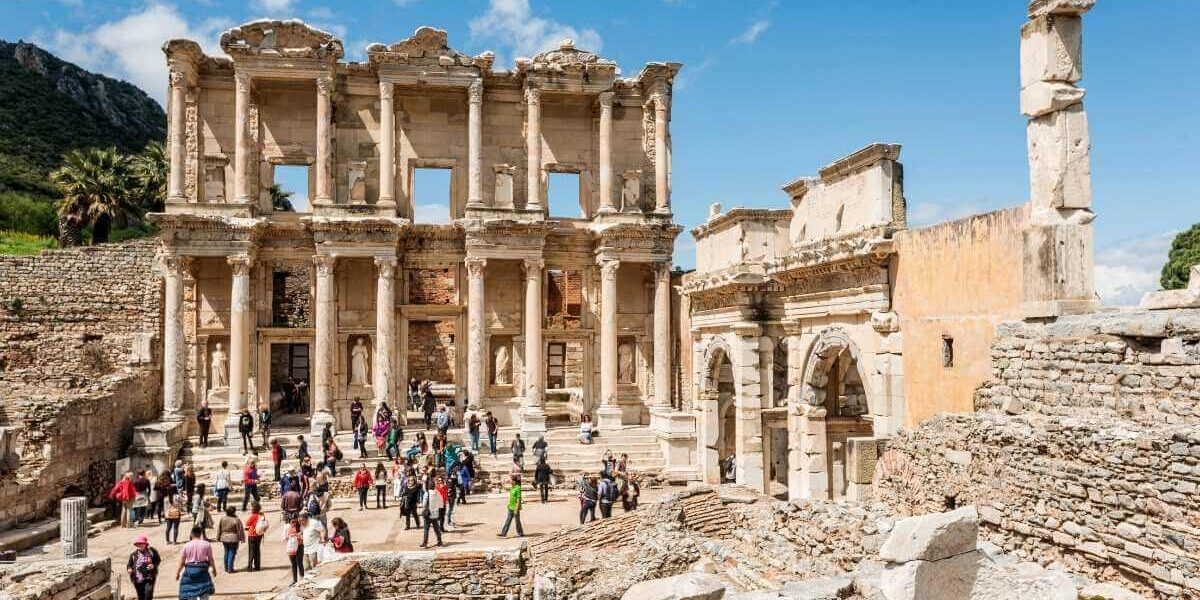Situated in modern-day Turkey near the Aegean coast, Ephesus offers an unmatched glimpse into ancient civilizations. Once a bustling port city filled with culture, commerce, and spirituality, Ephesus is now a treasure trove for archaeologists and travelers alike. The city’s history spans from its Greek origins through its ascendance in the Roman Empire, weaving a compelling tapestry of power, faith, and architectural prowess.
Greek Foundations: The Sacred Beginnings
First established by Attic and Ionian Greek settlers around the 10th century BCE, Ephesus was positioned strategically to thrive. According to legend, it was named after a queen of the Amazons and held the magnificent Artemision, a temple dedicated to the goddess Artemis. This temple would later be recognized as one of the Seven Wonders of the Ancient World, an enduring symbol of the city’s wealth and spiritual depth during the Archaic Period.
Transformation Under Persian and Hellenistic Rule
In the 6th century BCE, Ephesus fell into Persian hands, yet Greek culture continued to flourish despite foreign control. Following Alexander the Great’s conquests in the 4th century BCE, the city underwent a significant transformation. It emerged during this Hellenistic era as a burgeoning urban and commercial center, blending Greek and Eastern artistic influences, governance, and culture.
A pivotal moment came under Lysimachus, a general of Alexander, who strategically relocated the city to a better defensive spot and fortified it with massive walls, ultimately setting the stage for Roman expansion.
The Roman Zenith of Ephesus
Under Roman dominance, Ephesus reached its zenith, becoming the capital of the Roman province of Asia Minor. At its height, the city’s population exceeded 250,000, marking it as one of the largest urban centers of the Roman Empire.
This prosperous era saw monumental constructions:
- The Library of Celsus: Founded in the 2nd century CE, it was the ancient world’s third-largest library, showcasing stunning Roman architectural elegance.
- The Great Theatre: Designed to hold 25,000 spectators, this grand venue hosted gladiator games and dramatic performances.
- The Temple of Hadrian: A splendid structure paying homage to the emperor, merging Roman influence with Greek artistry.
- The Agora and Marble Road: These vibrant spaces were the nucleus of trade and political activities.
Additionally, Ephesus became a religious epicenter, with early Christianity making its mark. The city is depicted in the Book of Revelation and was visited by pivotal figures like apostles Paul and John. The House of the Virgin Mary, located nearby, is reputed to be her final resting place.
A Slow Decline and Rediscovery
Starting in the 3rd century CE, Ephesus began its gradual decline, caused by a combination of invasions, earthquakes, and the harbor’s silting, cutting off its crucial maritime link. Over time, as trade routes shifted, its significance dwindled, leading to abandonment by the 15th century.
However, archaeological efforts, primarily by Austrian teams from the late 1800s onwards, unearthed Ephesus’s hidden splendor. Today, it stands as one of the largest and best-preserved archaeological sites worldwide, drawing millions of visitors annually.
The Enduring Legacy of Ephesus
The narrative of Ephesus transcends mere ruins; it embodies a legacy of cultural continuity. Each epoch—from Greek to Roman to Christian—adds a new layer to its history. Wandering through Ephesus today, visitors are transported to a bygone era, where grand colonnades, imposing temples, and the allure of a once-thriving civilization captivate the imagination.
Traveler’s Frequently Asked Questions
Q: When was Ephesus founded?
A: Ephesus was established around the 10th century BCE, with potential earlier settlements in the region.
Q: What makes Ephesus historically significant?
A: Ephesus served as a vital hub for trade, spirituality, and political activity within the ancient world and was essential in early Christian history.
Q: What are the must-see attractions in Ephesus today?
A: Highlights include the Library of Celsus, Great Theatre, Temple of Hadrian, and the remnants of the Temple of Artemis.
Q: Is Ephesus mentioned in the Bible?
A: Yes, Ephesus is referenced in the New Testament and was among the Seven Churches of Revelation.
Q: How long should one spend exploring Ephesus?
A: Most guided tours last 2–3 hours, but history buffs may prefer to dedicate half a day or more for an in-depth experience.
Walking Through Time at Ephesus
The legacy of Ephesus is carved into the stone, telling tales of empires and ideas that continue to intrigue travelers and historians alike. Its journey from a Greek outpost to a Roman stronghold and then to a Christian hallmark stands testament to the resilience of culture through centuries.
In summary, Ephesus is not only a remarkable historic site but also serves as a reminder of the fascinating tales woven into the fabric of our past. To explore this enchanting city, consider utilizing LocalsRide to effortlessly secure a transfer service that meets your needs, ensuring a hassle-free travel experience. With transparent pricing, a broad selection of vehicles, and a user-friendly platform, LocalsRide empowers travelers to truly relish their adventures without unnecessary stress.
While facts and stories can ignite interest, nothing compares to the experience of standing amidst the ruins and breathing in the history. Book your ride with verified providers at reasonable prices through LocalsRide.com. The platform offers great vehicle options and additional services tailored to personal preferences that add to your travel experience. Book your transfer and explore Ephesus without missing a beat!

